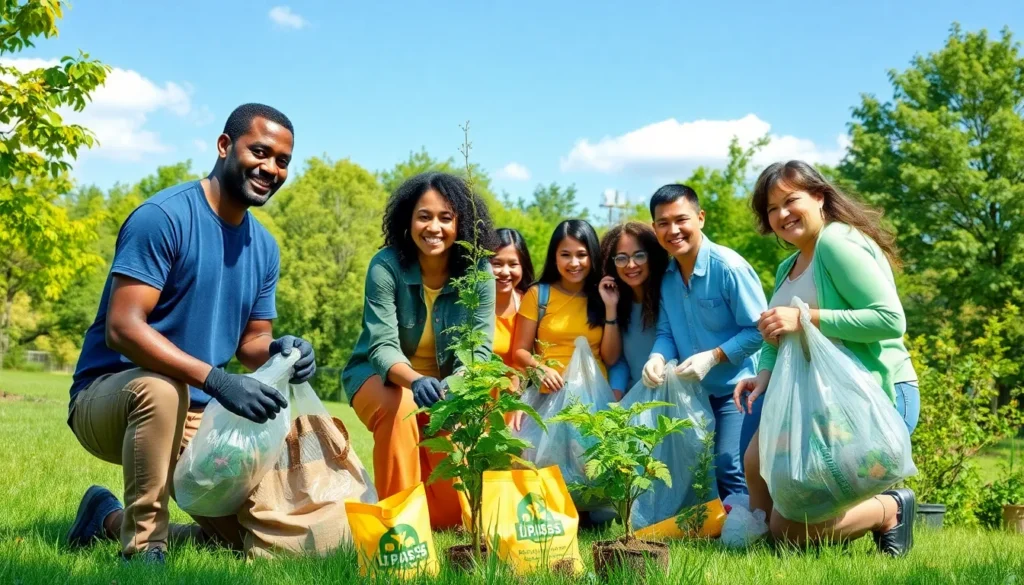In a world where plastic straws have become the villain of our oceans and climate change feels like an unwelcome guest at the party, sustainable change is the superhero we never knew we needed. It’s not just about hugging trees or recycling bottles; it’s about making choices that benefit the planet while still enjoying life’s little pleasures. Who says saving the Earth can’t come with a side of fun?
Table of Contents
ToggleUnderstanding Sustainable Change
Sustainable change involves implementing strategies that create lasting environmental benefits. Addressing plastic pollution and climate change requires a broad understanding of how individual actions contribute to a larger impact.
Definition and Importance
Sustainable change refers to modifications in practices and policies aimed at minimizing environmental harm. Emphasizing a comprehensive approach, it seeks to balance economic growth with ecological integrity. Prioritizing sustainability leads to healthier ecosystems, improved public health, and a more equitable society. Integrating sustainable change fosters resilience against climate-related challenges. By focusing on long-term effects, communities can develop strategies that benefit future generations.
Principles of Sustainable Change
Sustainable change operates on key principles that guide effective strategies. Community involvement ensures that voices are heard and diverse perspectives shape solutions. Education promotes awareness around environmental issues and encourages active participation. Collaboration across sectors strengthens efforts and unifies resources. Innovation drives the development of sustainable technologies that reduce waste and conserve resources. Accountability helps maintain transparency and commitment to achieving environmental goals. Each principle plays a crucial role in facilitating meaningful and lasting change.
Strategies for Implementing Sustainable Change

Implementing sustainable change requires clear strategies that engage communities and shape policies effectively. Focused efforts on these areas create meaningful, long-lasting impacts.
Community Engagement
Community engagement serves as a foundation for sustainable change. Active participation from residents fosters a sense of ownership in environmental efforts. Educational workshops on waste reduction and conservation practices empower individuals to make informed choices. Local partnerships with organizations amplify outreach initiatives while encouraging collective action. Initiatives that support volunteering at cleanup events or local gardens build stronger connections among community members. Inclusivity in decision-making processes ensures that diverse perspectives shape sustainable practices, enhancing acceptance and commitment to the shared goals.
Policy Development
Policy development supports the framework for sustainable change. Formulating policies that prioritize environmental protection guides organizations toward sustainable practices. Regulatory standards on emissions and waste management encourage businesses to adopt greener alternatives. Collaboration between governmental agencies, industries, and non-profits leads to comprehensive approaches that address environmental challenges. Implementing incentives for renewable energy adoption motivates businesses and individuals to invest in sustainable technologies. Ongoing evaluation of existing policies helps adapt strategies to evolving environmental needs and advances in science.
Challenges in Achieving Sustainable Change
Sustainable change faces multiple challenges that hinder progress. These challenges include resistance to change and resource limitations, both of which require thoughtful strategies to address.
Resistance to Change
Resistance often emerges from individuals and organizations hesitant to modify established practices. Change evokes uncertainty and fear regarding the unknown, leading to reluctance in embracing new methods. Cultural norms and beliefs may also create barriers, as deep-rooted habits can be tough to alter. Training and communication play crucial roles in this context. Providing clear information on the benefits of sustainable practices helps mitigate fears. Engaging stakeholders early in the process fosters a sense of ownership. Community-led initiatives often overcome resistance by demonstrating small successes that inspire broader commitment.
Resource Limitations
Resource limitations significantly impact the ability to implement sustainable practices. Financial constraints often prevent communities from investing in greener technologies and infrastructure. Access to funds varies widely, with many areas lacking sufficient financial support for sustainability projects. Human resources also create challenges, as organizations may struggle to find skilled personnel dedicated to sustainability efforts. Effective partnerships between public and private sectors can alleviate some resource constraints. Sharing resources among community members can optimize the impact of individual contributions. Collaborative efforts lead to innovative solutions that utilize existing capabilities.
Examples of Successful Sustainable Change
Sustainable change manifests in various successful initiatives worldwide. These examples showcase effective strategies across different sectors.
Case Studies
A leading example comes from Denmark’s cycling infrastructure. Copenhagen encourages cycling as a primary mode of transport, resulting in a 62% cycling rate among residents. Another notable case is Patagonia, the outdoor clothing company. Their commitment to environmentally friendly materials and transparency has inspired other brands. In New Zealand, the Zero Carbon Act aims to reduce greenhouse gas emissions to net-zero by 2050, fostering government and community collaboration.
Lessons Learned
Implementing successful sustainable change relies on collaboration among stakeholders. Engaging communities in the decision-making process enhances ownership and effectiveness. Continuous education also plays a vital role, empowering individuals with knowledge about sustainability. Additionally, transparent practices build trust within partnerships. Companies can enhance brand loyalty by demonstrating their commitment to the environment, driving consumer choices toward greener alternatives.
Sustainable change is a vital pathway toward a healthier planet and society. By embracing innovative practices and fostering community engagement, individuals and organizations can drive meaningful progress. The journey toward sustainability is not just necessary; it can also be enjoyable and rewarding.
Overcoming challenges requires collaboration and commitment from all sectors. With the right strategies in place, communities can thrive while minimizing environmental impacts. As awareness grows and collective action strengthens, the potential for a more sustainable future becomes increasingly attainable. Embracing these principles ensures that the efforts made today will leave a lasting legacy for generations to come.






